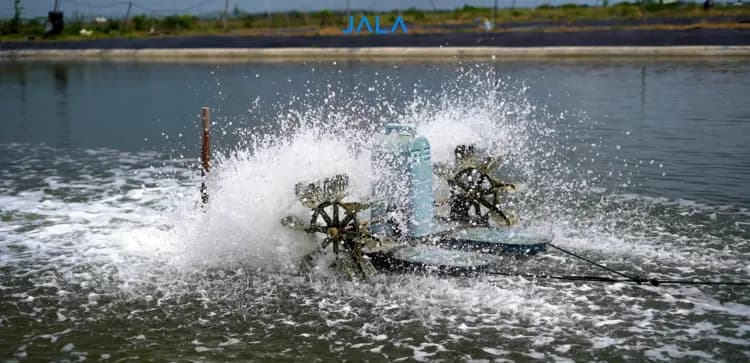
Moss is one of the plants that can grow in shrimp farms. Excessive moss growth in farms can lead to loss in shrimp cultivation, as moss decreases water quality and hinders shrimp growth. Moss can be removed by improving and maintaining pond water quality, installing netting fences, and using biological agents. Learn more about how to prevent and get rid of moss in your shrimp farm through this article.
How to Get Rid of Moss in Farms
1. Improving and maintaining pond water quality
Poor water quality, with a salinity level that is too low (below 15 ppm) and an overly high organic matter concentration (over 90 ppm), can lead to moss growth. Therefore, farmers need to regularly and accurately conduct water quality checks to anticipate drastic changes in water parameters. Moss also grows well in lower water pH (below 7.5). Farmers can overcome this by giving dolomite treatment. Installing sufficient aerators also helps maintain oxygen circulation in the pond.
Read more: Four Important Physical Parameters of Water Quality in Shrimp Farms
2. Installing netting fences
Moss is an organism that photosynthesizes to survive. Thus, it thrives in farm environments with ample sunlight intensity. Installing netting fences to reduce sunlight exposure in the farm can help to get rid of moss.
3. Using biological agents
Biological agents can be another way to get rid of moss in farms. Application of probiotics or decomposing bacteria in the pond can break down organic matter in the water to hinder moss growth. Increasing plankton population by giving just enough fertilizers also help reduce the clarity of pond water, controlling the sunlight intensity. Moreover, keeping moss-eating fish like milkfish and rabbitfish can help reduce existing moss growth.
4. Cleaning and disinfecting the pond
Cleaning the pond is essential during cultivation as well as when transitioning to a new cycle. Apply disinfectant during pond preparation to prevent moss growth. During cultivation, clean the walls and bottom of the pond regularly. Remove leftover feed and shrimp waste to prevent buildup, which can promote moss growth. Additionally, conduct siphoning to remove mud from the bottom of the pond.
5. Implementing feed management
Another important step to get rid of moss is through proper feed management. Adjust the amount of feed according to shrimp’s needs to prevent overfeeding, which causes a buildup of feed waste and decreases the water quality. Check feeding trays to monitor shrimp appetite and help determine the right amount of feed.
Causes of Moss in Shrimp Ponds
Moss in shrimp ponds can be caused by several factors. High sunlight intensity and an overly high water clarity can accelerate moss growth. Also, accumulated leftover feed and shrimp waste that are not cleaned out also support moss growth, as these organic materials become a nutrient source for moss.
Dangers of Moss in Shrimp Farms
Although it does not directly cause diseases, excessive moss can affect shrimp health. Moss can serve as a host for various pathogens like White Spot Syndrome Virus (WSSV) and Vibrio bacteria.
Besides pathogens, moss can also be a breeding ground for parasitic protozoa. These parasites can enter the shrimp’s gills, blocking respiration and reducing appetite.
Conclusion
Uncontrolled moss growth in shrimp farms is one of the causes of cultivation loss. Here are the ways to get rid of moss:
- Improving and maintaining pond water quality
- Installing netting fences
- Using biological agents
- Cleaning and disinfecting the pond
- Implementing feed management
Aside from getting rid of moss in the pond, optimize your cultivation with regular recording and monitoring by using JALA App. JALA App is a shrimp farm management application that helps you better understand pond conditions, allowing you to make suitable adjustments. With JALA App, you can record various cultivation parameters, including water quality, which is crucial to monitor to prevent excessive moss growth.
Haven’t registered at JALA App? Sign up now at app.jala.tech and download the mobile version on Google Play Store or App Store!





